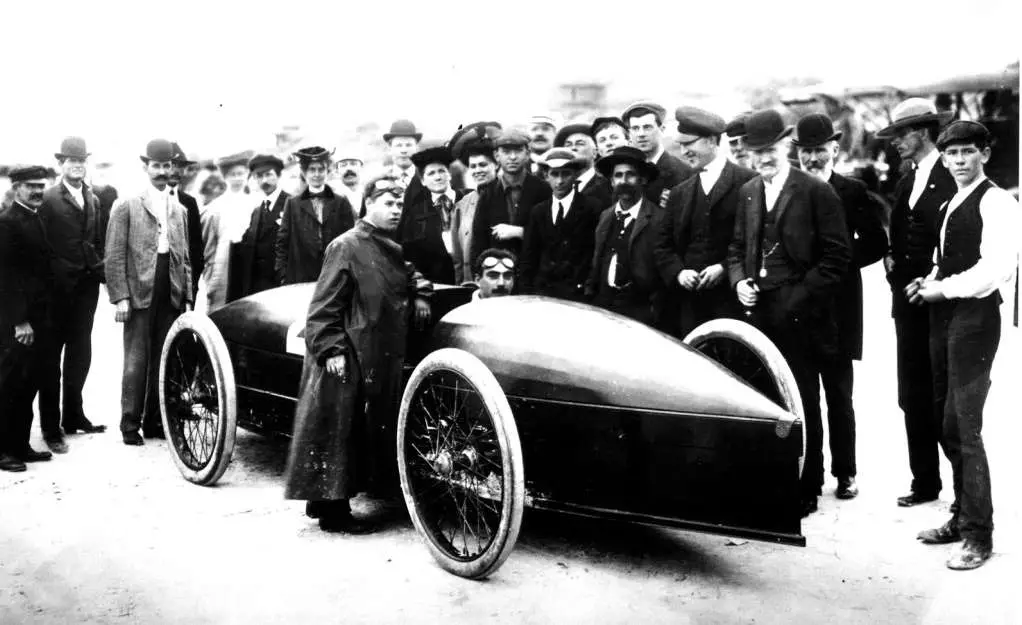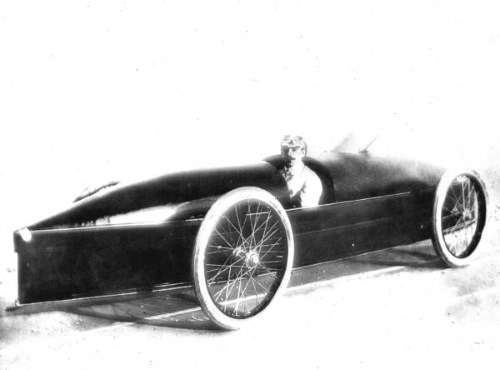Fred Marriott was the chief mechanic at the Stanley Steam Carriage Co., when the company owners asked him to race a steam car at a nearby track. Though gasoline-powered cars would soon eclipse the steamers, Marriott set a speed record that no one would break for a century.
The Stanley Steamer, invented by a pair of Maine twins, was the first automobile sold in commercial quantities. F.O. and F.E. Stanley made and sold more than 10,000 cars from an old bicycle plant in Watertown, Mass., between 1897 and 1914. Fueling the cars involved uncoiling a hose from the side of the car and putting the free end into a horse-watering trough.
Fred Marriott
Marriott was no kid when he began racing. He was in his 30s, having been born in Needham, Mass., on Dec. 31, 1872.
At first he raced locally at the Readville Race Track, where autos and horses set speed records and politicians, socialites, sportsmen and gamblers mingled.
Then in 1906 the company built a steam-powered race car using an aerodynamic design. They called it the Stanley Rocket. Three-feet wide and 16-feet long, it was described as an upside-down canoe. Made of canvas and glue, it weighed 1,600 lbs., but carried 1,000 lbs. of steam per square inch.
Fred Marriott went down to Ormond Beach in Daytona, Fla., with the Stanley Rocket. On Jan. 23, 1906, he set the land speed record. He sat on the floor of the Rocket with his foot on the brake as the steam pressure built up, then let go and WHOOOSH!
He drove one mile in 28-1/5 seconds, or 127.6 miles per hour. That record wasn’t broken for a steam machine until 2009.
Career Ender
In 1907, Fred Marriott tried to break his own speed record in an improved version of the Stanley Rocket. He hit a rut going about 150 mph. The car went flying and broke in half when it hit the ground. Marriott was injured, lost an eye and gave up racing. He described what happened:
I shouldn’t have tried to shatter all records…She wasn’t heavy enough. I thought I could make her do two hundred. But that confounded combination of speed, light weight and treacherous sand spun me around, shot me eighteen feet in the air. it was the last time I ever raced a car.
He continued working at the Stanley Steam Carriage Co., where he kept a log book, recording the model type, serial number and date of delivery for every car produced from 1904 to 1923.
Fifty years after he broke the record, an automobile collector tried to persuade Marriott to return to Daytona to celebrate, but he wouldn’t. Fred Marriott died shortly thereafter, on April 28, 1956.
In 2012, Marriott’s granddaughter brought his medals to PBS’s Antiques Road Show for an appraisal. The appraiser put a value on his medals and trophy at between $12,000 and $18,000, and $5,000 for the log book.
This story last updated in 2022.






3 comments
[…] brought clients by to see him. He still played ice hockey for an amateur team, and took up auto racing and polo. He confided to a reporter that he wished no one wrote anything about him. He was offered […]
[…] Rocket. Three feet wide and 16 feet long, it was described as an upside-down canoe. Race car driver Fred Marriott in 1906 drove the Rocket 127.66 mph on the hard sand of Ormond Beach, Fla., setting a world speed […]
[…] collapsed, the steam car managed to strike one last blow against the tide of gas cars; the land speed record for all motor vehicles was set in 1906 by a driver in a Stanley steam car, hitting 127 miles per […]
Comments are closed.